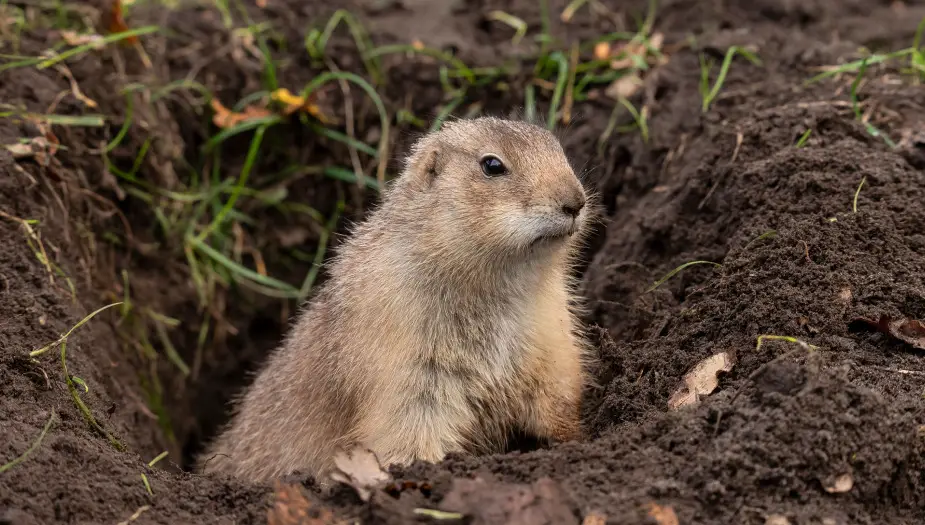Gophers are burrowing animals and inhabit vast networks of tunnels underground. If you have ever wondered what gopher burrows look like, how they are constructed, or what they are used for, this blog post is for you. In this post, we will take a closer look at gopher burrows and uncover the secrets that lie beneath the surface.

Gophers are small, furry creatures that are known for their ability to dig complex and extensive burrow systems. These burrows serve as their homes, protection from predators, and a means to reach food sources. Gopher burrows are quite intricate and can have a variety of chambers and tunnels that serve different purposes.
Gopher Burrows and Gopher Tunnels
The actual structure of a gopher burrow can vary depending on the species, but most gopher burrows are characterized by a short entry tunnel that leads to a main tunnel, which serves as the primary highway for the gopher. From this main tunnel, smaller tunnels branch out, leading to various rooms, including storage areas, nesting chambers, and latrines.
One unique characteristic of gopher burrows is their “plug” system. Gophers are known to dig a false tunnel, which they then block off with dirt, debris, or feces. This plug system is designed to trick predators, who will attempt to follow this false trail, leaving the gopher burrow system unscathed.
What is the purpose of gopher burrows?
Gopher burrows serve a variety of purposes for gophers.
They provide shelter and protection from predators, a means to reach food sources, and a place to store food and hoard items for later consumption. The burrows also help maintain soil structure and nutrient cycles through tunneling activities.
However, gopher burrows can also have negative impacts on human activities, such as creating unsightly mounds, damaging root systems of plants, and causing holes in the ground that can be hazardous.
How can gopher burrows be managed?
Gopher burrows can be managed in several ways, depending on the severity of the problem and the location of the burrows. Here are some common methods:
- Trapping: Live trapping is an effective way to reduce the gopher population in a specific area. Traps can be placed in the burrow entryways and monitored to remove any gophers that are caught.
- Repellents: There are several commercial or homemade repellents that can be used to discourage gophers from burrowing in specific areas. These repellents work by creating an unpleasant odor or taste, which makes the area less attractive to gophers.
- Barrier installation: Installing underground barriers made of wire mesh or hardware cloth is an effective way to prevent gophers from entering specific areas.
- Fumigation: Fumigants can be used to kill gophers in their burrows. However, this method is hazardous and must be done by a licensed professional.
- Natural predators: Animals like snakes, owls, and hawks are natural predators of gophers and can help reduce their population.
It’s important to remember that gophers are an essential part of the ecosystem, and removal of all gophers is not recommended. Care should be taken to manage their populations while maintaining their importance in their environment.
What Does a Gopher Tunnel Look Like?
Gopher tunnels are often hidden beneath the surface of the ground, making them difficult to detect visually. However, if you know what to look for, you can usually identify gopher tunnels by the presence of certain signs. One of the most obvious signs is a gopher mound, which is a crescent-shaped pile of soil that is often found near the entrance to a gopher tunnel. These mounds are formed when a gopher excavates soil from its tunnel and pushes it up to the surface.
Another sign that a gopher tunnel is present is a dip or depression in the soil. If you notice an area of the ground that seems to sink or sag, it may be an indication that a gopher tunnel is present below. Additionally, vegetation that is being destroyed or wilted in a specific area may be a sign that gophers are burrowing in that area.
If you are able to dig down to the tunnel, you’ll usually find a feeding tunnel and a nest chamber. The feeding tunnel is the primary tunnel where the gopher travels to access food sources, while the nest chamber is a secondary space where a gopher will rest or raise its young. These chambers are characterized by loose soil and smooth walls, and the entrances are slightly wider than the rest of the tunnel. Overall, a gopher tunnel is often hard to detect visually, but with the presence of the signs mentioned, you may be able to identify their tunnels.

